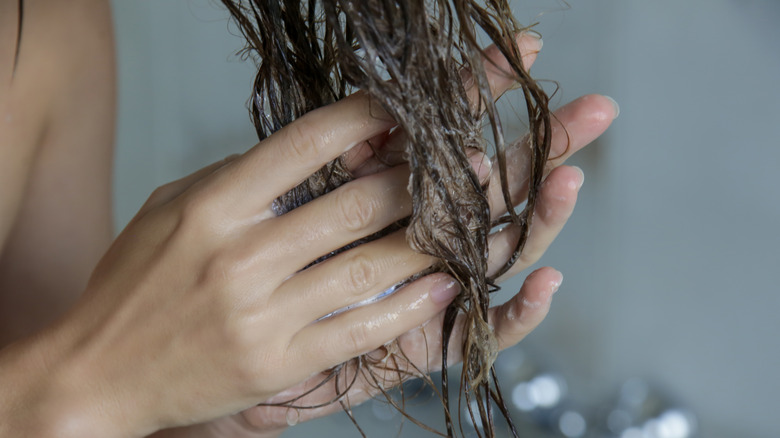Curl Training Is The Viral Hair Trend That Adds Extra Definition To Your Wavy Mane
Whether you already have curly tresses or you're trying to create waves that will last for days, curl training is an option you might want to consider. If you've never heard of it, the basics are relatively simple — curl training involves styling your hair the same way repeatedly over time to preserve defined curls. If you already have some, you're halfway there, but even those with wavy tresses can eventually work their way up to a curlier 'do.
As of late, curl training has grown in popularity, with social media influencers sharing their results on platforms like TikTok. However, it's important to note that curl training isn't about going from straight, flat hair to curly tresses full of volume. While you can certainly add extra definition to your hair with this process, the ultimate goal is to help your natural curls shine — you shouldn't expect it to become more curly, for example, or adapt to a single pattern.
If you're ready to start curl training, be sure to set aside a decent chunk of time to get it done. Depending on your curl type, you may need to allow your hair to set for a few hours or overnight to get the results you desire. Additionally, curl training is not a one-step process — it's a routine that needs to be repeated to ultimately get the volume, definition, and style you want.
How to help your curls 'remember' their pattern
To begin the curl training process, you need to gather your supplies. You might want to have a detangler on hand if your tresses are particularly knotty, but perhaps the most essential product to have is your favorite leave-in conditioner or hair mask. Begin the process by washing your locks with a clarifying shampoo to remove any excess oil or dirt. While your hair is still wet, work in your leave-in conditioner or hair mask, and then start twisting or finger-coiling your tresses. The goal is to help your curls "remember" their natural curl pattern. However, it's important to keep in mind that you may not see noticeable results until you're a few sessions into your training.
The idea behind achieving more definition through this process is based on clumping. As many curly-haired ladies already know, clumping is when your curls come together and form bunches. To get the extra volume and definition you want, curl training can gently help your tresses along and promote the "bunching" effect. However, taking care of your locks throughout the process is just as essential as the training itself. This means taking extra steps, like rinsing your hair with cool water after a wash to prevent frizz. Give your curls plenty of time to set during every session as well — throw on a shower cap or bonnet, kick back, and relax.
Going the extra mile while curl training
As you begin the curl training process, you might want to document your journey along the way. While it sounds a bit extra, doing so can give you a better idea of where you can improve, whether it's by focusing on moisturizing your locks or "training" your curls for longer periods of time. It's also a good idea to create a routine or schedule you can stick to if you're serious about seeing noticeable results. For example, you can pick one day a month to use a clarifying shampoo, and select certain days of the week that you want to put aside time for curl training.
If it's been weeks since you started and you're still not seeing a difference in your tresses, use the process of elimination to determine what might be causing the hang-up. For instance, you may want to switch up the hair products you're using, especially if they aren't formulated for your hair type. You might also want to saturate your tresses with more water prior to curl training, especially if frizz is a problem.
Generally speaking, curly hair is more susceptible to issues like dryness, according to the American Academy of Dermatology Association. Beyond curl training, you can take care of your tresses by keeping them untangled, moisturized, and only washing them when necessary (every two to three weeks may be sufficient).

